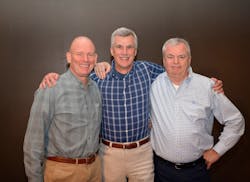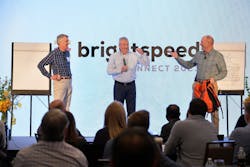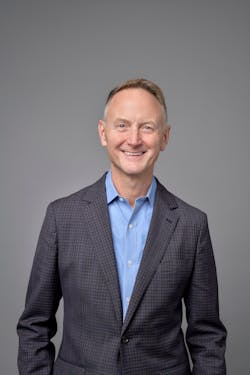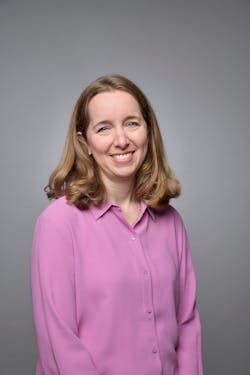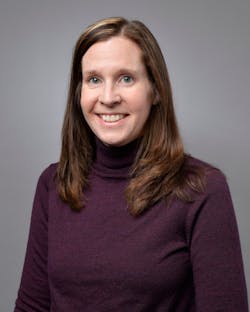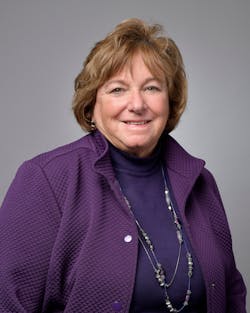Executive Insights with Brightspeed’s Co-Founders and ISE EXPO 2023 Keynote Presenters
What drives three retired Verizon executives to retire from their retirement? Learn what leads them to transform a network from copper to fiber across 20 states, create a "network build" culture and walk their talk that "people matter".
“Since the Day One launch, we have been hyper-focused on our big three strategic priorities. Whether you are a new employee or a former Lumen employee now a Brightspeed employee, you know that Brightspeed has three main priorities: stabilize and improve the customer experience, build and sell our state-of-the-art fiber network, and enable our Brightspeed workforce. We all work together to ensure success in all three priorities. It’s as simple as that.” — Tom Maguire, COO, Brightspeed
Topic: Six Month Realities
ISE: April one—six months after launching as a standalone company—Brightspeed started selling its FTTP gig Internet service. Congratulations! What surprised you about the nuts and bolts of making this happen? Is there anything you would do differently now that you know what you know?
Tom Maguire: Believe it or not, I was surprised at how smoothly we launched—and I attribute this to the team’s preparation. I knew our team, especially the IT crew, put in countless hours with their counterparts with the previous owner to ensure that every loose end was secure, but I never imagined that things would have gone as smoothly as they did. Sure, we experienced a few bumps, but we quickly addressed and remedied them.
The fact that pretty much no one noticed that anything happened is the result of the Brightspeed and Lumen teams’ diligence and hard work.
Bob Mudge: Creating a “build ecosystem” in states that had minimal recent investment has been a big challenge. Beyond all the job functions that need to be expanded and the partners that must be engaged, there are intangible pieces that contribute to a network build culture. We needed to work extra hard to create a new culture. That said, launching our new product in just six months was a major accomplishment by our team.
Chris Creager: The core network needs more improvement than we anticipated. We knew the outside plant network had received little investment over the past few years, but the amount of investment to stabilize and improve the core network was surprising. Given the supply chain lead time for new equipment and cards, I wish we had spent more time assessing the core network at a deeper level. This has slowed our fiber roll out in some areas.
Topic: Risks
ISE: What’s the biggest professional risk you’ve taken during this launch?
Mudge: This stage of my career is very different and so is my role. I feel personally accountable to deliver on the Brightspeed promise we are making to customers who are often in underserved areas. I feel equally responsible to the Apollo team. I want to ensure their investment delivers the outcome they expect. Apollo was the catalyst for this endeavor, and they have provided bold leadership to make this happen.
Creager: The biggest risk was getting involved in so many different facets of creating the business. There were only a handful of employees and advisors, so we needed to jump in and create every aspect of this business, even if it wasn’t an area where we had prior experience. I remember being on calls discussing things like defining our general ledger accounts and risk management strategies before our CFO was hired. I’m definitely not an accountant, but I knew enough to engage the right people to figure it out. While it was a risk, it turned out well and it was a lot of fun.
Maguire: This is a little weird to ask a group of people that were basically retirees when we started this company, but I, for one, was very concerned about our reputations in the industry. Collectively we’ve spent over a century in the business building that reputation, and failure to deliver would definitely tarnish our reputations. I love what we’re building today and am excited for the legacy we are building for Brightspeed.
Topic: Leadership Style
ISE: Please share your leadership style and ONE word that encapsulates it.
Mudge: Driven.
Creager: I would say my style is authentic. As a broader leadership team, I would describe us as transparent, direct, and honest in our communications with each other and with our employees. Our leadership is who we are, and we do not behave differently as a leader or as a person.
Maguire: I was going to say annoying, but I think I’ll go with fair instead. I try not to take a my-way-or-the-highway approach to things because I realize that I am not the smartest or most experienced person in the room. I need to listen to what others have to say. Granted, I may stray at times, but that’s typically to immediately solve a problem or dissipate a challenge. Otherwise, it is in the company’s (and my) best interest to be fair to everyone I encounter.
Topic: Core Beliefs Meet Real Life
ISE: The executive team developed a set of core beliefs (below) before your network went live. Now that you’re in the weeds, what’s the hardest one to deliver on as you progress? Why?
- We believe people matter.
- We believe in thinking like customers.
- We believe in being real.
- We believe in delivering on big ideas.
- We believe in the speed of light.
- We believe in celebrating success.
Maguire: I think the team is doing a good job of keeping egos in check and thinking like our customers (internal and external), but I’d like to see things go a little faster, especially the fiber build. We put a lot of thought into design and location of the build, but some of the things that have challenged the industry are still out there, such as permitting, pole attachments and locates—nothing new to the OSP world. Unfortunately, we are dependent on others’ timelines, and it can be a slow-paced process. We want and need to move faster.
I look at places like Boston, where Bob directed the One Fiber build, and marvel at the way they simplified processes like permitting to accelerate construction. Unfortunately, we don’t have uniform processes across all markets. I wish we could change this. Imagine when infrastructure subsidies hit, and providers are held up because a location will only issue a limited number of permits at a time—this is the reality we face.
Mudge: Moving at the speed of light is a challenge because so many external factors have an impact on our network build. When we work with municipalities that have a clear vision for bringing our fiber technology to their constituents, the process goes much faster. But again, looking back at only taking six months to launch our Brightspeed fiber product is a great indicator that we are working hard at an accelerated speed.
Creager: It’s probably hardest to deliver on celebrating success. While I’m incredibly proud of what our employees have accomplished, and I love celebrating their accomplishments, I’m so focused on tackling the next big milestone that I need to make a concerted effort to stop and ensure the team looks back at what we’ve created and have accomplished in our first several months. We have a lot to be proud of.
Topic: Out of the Box Thinking
ISE: How has the Brightspeed team colored outside the lines to do business differently and better for its employees?
Mudge: We are creating a culture of minimal hierarchy and ensuring our frontline employees have a voice. They work with our customers on a daily basis and know what our customers are saying and what they want. They are customer service experts in the field. So, we listen to them, tap into them as a resource and empower them to ensure our customers are receiving the best service in the industry. From day one, we have been transparent and clear with Brightspeed employees. They know that our customers are a priority. This isn’t just something we say, it’s how we approach our business.
Creager: One of our core beliefs is people matter. When we launched the company, we announced a program called the Shared Success Plan for all employees. It was a chance to solidify our commitment to this belief by creating an opportunity for every Brightspeed employee to share in the value we create together. No matter your role in this business, every employee has an opportunity to earn thousands of dollars when there is a future change in control of the company. Not many companies give employees this opportunity. It also aligns all of us around one set of common goals—creating value for our customers and the business.
Topic: Challenges
ISE: What’s been the most challenging part of your job?
Mudge: We are making great progress improving our processes for better customer service. However, we acknowledge that we have a lot to do in this area. The opportunity to be the best network provider in the world is within our grasp, but the pace to get there will never be fast enough.
Creager: Building a network of this size and scope from scratch is a very complex and challenging task and can only be done with the integration of hundreds of vendors and suppliers. I believe in being real and authentic. It’s frustrating when someone makes a commitment to provide certain services, but lacks follow through and accountability to deliver. I’ve always believed in under-promising and over-delivering. Unfortunately, not everyone employs this philosophy.
Maguire: I do not do well when dealing with things that are not in my direct control. I get very frustrated when customers are clamoring for broadband service, and I cannot deliver it because their local municipalities won’t locate utility lines in a timely manner. For us to build a network, we need to know where we can build and are dependent on local municipalities. When we face this type of challenge, I’d just like the opportunity to bring in a team to locate and mark infrastructure on their behalf. This is one way of thinking outside of the box.
“We are creating a culture of minimal hierarchy and ensuring our frontline employees have a voice. They work with our customers on a daily basis and know what our customers are saying and what they want. They are customer service experts in the field. So, we listen to them, tap into them as a resource and empower them to ensure our customers are receiving the best service in the industry.” — Bob Mudge, CEO, Brightspeed
Topic: Inspiration
ISE: As an organization gets larger, there can be a tendency for the “institution” to dampen the “inspiration”. How do you continue to inspire and engage?
Creager: We haven’t seen that happen in our organization. Our vision is straightforward—build a fiber network to deliver a superb broadband service and customer experience to parts of the country that don’t have access today. It’s a compelling mission that employees are excited to take on. People get it. This is empowering to people and communities that otherwise would never have this opportunity. If anything, enthusiasm has grown as we expand.
Maguire: One way to ensure this doesn’t happen is to manage from a customer perspective rather than top-down. Now, I’m definitely not saying we throw caution to the wind. After all, we have budgets, but if we keep an eye on what’s really important—our big three of service improvement, building fiber, and enabling employees—I think we’ll avoid a lot of institutionalizations.
Mudge: We continue to remain transparent and clear on our strategy by keeping it simple with three strategic priorities: stabilize service to rebuild our reputation, build a next-generation fiber network, and enable and invest in our employees. We want to make sure our employees feel vested in achieving our strategic priorities—our success is their success. This will help keep them inspired and engaged. Part of my role is to keep us nimble and very focused on these three simple priorities.
Topic: Team Member Kudos
ISE: Please share a team member who has moved the needle for Brightspeed’s network and a specific example of what he/she/they have accomplished.
Mudge: I need to pivot on this question. There are dozens of remarkable people who have accomplished more than I could ever imagine, some of which I know Tom and Chris can highlight. Instead, I would add that our incredible support teams in finance, HR, legal, IT and others have also been incredible creating an entirely new business while we also transform our network.
Sherry did everything when we started out. Operations, finance, HR, TSAs, you name it, she did it. When she agreed to stay on and lead the fiber build, I knew we could not help but be successful. She is a giant in a field of giants, and I know my life would have been a lot tougher had she not been along for the ride.
Topic: Permitting and Easements
ISE: With BEAD funds being distributed soon, there’s been much debate in DC about permitting and other approval processes that can result in significant deployment delays and increases in cost.1 What would help solve these challenges?
Maguire: Streamlined permitting and approval processes would be a win all around. BEAD funds are great. Unfortunately, the funding only goes so far in bridging the digital divide. The process to get permitting for the infrastructure needed to bring high speed Internet to rural and underserved communities can be laborious and lengthy. As a new broadband company that is hyper-focused on rural and suburban communities, we are working to build the relationships in the communities we serve and elevate our reputation as a responsible corporate citizen. We are committed to finding ways to easily navigate the permitting and approval processes. Right now, there is no one-size-fits-all solution to this issue as each community is unique.
“Our vision is straightforward—build a fiber network to deliver a superb broadband service and customer experience to parts of the country that don’t have access today. It’s a compelling mission that employees are excited to take on. People get it. This is empowering to people and communities that otherwise would never have this opportunity. If anything, enthusiasm has grown as we expand.” — Chris Creager, Advisor and Board Member, Brightspeed
Topic: Smooth Integration
ISE: While you’re a new company, you also welcomed team members from Lumen, a legacy provider. How did you welcome them and grow as a fully integrated company?
Maguire: Since the Day One launch, we have been hyper-focused on our big three strategic priorities. Whether you are a new employee or a former Lumen employee now a Brightspeed employee, you know that Brightspeed has three main priorities: stabilize and improve the customer experience, build and sell our state-of-the-art fiber network, and enable our Brightspeed workforce. We all work together to ensure success in all three priorities. It’s as simple as that.
Mudge: We were very intentional in creating our own culture at Brightspeed and fostering inclusion, transparency, and a customer-centered approach to doing business. No matter how you became a Brightspeed employee, once you are on team Brightspeed, you are expected to adopt that mindset and approach when tackling everyday tasks and responding to our customers. We are a highly collaborative, mission-focused, and results-driven organization. When one succeeds, we all succeed. Success is ensuring our customers get what they pay for and live a connected life. We are also listening to the frontline workers—they know the communities, the customers, and the needs. By empowering them to share their voice and make real-time decisions in the field, we are meeting customer needs immediately.
Topic: ISE EXPO 2023 Opening Keynote: “A Fiberside Chat”
ISE: Share a few topics you’ll address during the upcoming panel keynote discussion. Why should readers/attendees join you at ISE EXPO for the keynote?
Maguire: Because we’re entertaining, of course.
Mudge: We came out of retirement to build a new company with a fresh approach to doing business in the telecom industry and we are going to tell you why. Spoiler alert: it’s a great story.
REFERENCES AND NOTES
1. “Breaking Barriers: Streamlining Permitting to Expedite Broadband Deployment”: https://energycommerce.house.gov/events/communications-and-technology-subcommittee-legislative-hearing-breaking-barriers-streamlining-permitting-to-expedite-broadband-deployment
About the Author
Sharon Vollman
Content Ambassador for ISE EXPO
Sharon Vollman is the Content Ambassador for ISE EXPO. She is passionate about collaborating with thought leaders, SMEs and hard-working doers who design, plan and deploy ultra-reliable broadband networks. Vollman is committed to creating a variety of educational offerings for ISE EXPO attendees that inspire them to connect every U.S. citizen with the broadband networks we all want for our children and grandchildren.
Vollman has created educational partnerships with Broadband Service Providers including AT&T, Verizon, Lumen, Frontier Communications and others. She has covered the telecom industry since 1996.
